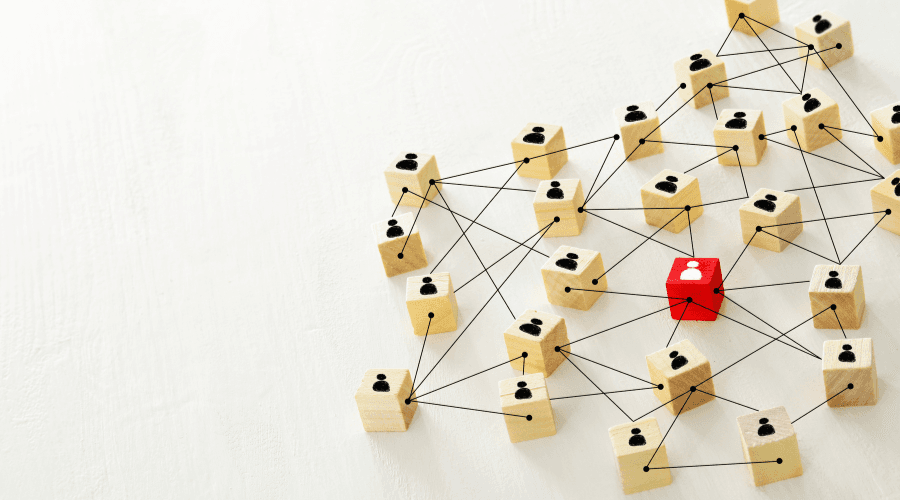Recasting the ‘middle man’ — the role of charities in the age of disintermediation (Pt 2)
In part two of our series on the role of disintermediation in charitable giving, Meredith Niles discusses why disintermediated giving could be more attractive than traditional charitable giving (in some situations). She also shares some of the ways in which charities might respond to these changes in donor giving patterns.
- Written by
- Meredith Niles
- Added
- June 29, 2023
What motivates a donor to leave out the charity ‘middle man’ and give directly to a beneficiary?
In part one of this series, I talked about what disintermediation in fundraising looks like and explored the impact it can have on giving. Together we looked at a selection of examples that showed how the public responded philanthropically to the war in Ukraine, and how this response could help us explore disintermediated giving in action. If you missed part one, and need to catch up first, please do so here.
I believe that the most appropriate response to the growing visibility of disintermediated giving is neither to shrug it off as statistically insignificant nor to rush to develop a platform strategy that rivals that of AirBnB. Instead, I think charities should reflect on what disintermediated giving might be offering donors that a traditional charitable giving experience is lacking.
We should listen carefully to the reasons they offer for giving in this way and seek to understand what their actions reveal about their true preferences, using this insight to design new strategies to capture the imagination of these potential donors.

So today, in part two, I’ll offer suggestions on why I think disintermediated giving can be (in some situations and for some individuals) more attractive than traditional charitable giving. I will also share some ways in which charities might respond. Let’s get started:
1. Disintermediated giving can offer a greater sense of personal connection than giving through charity.
When a person gives money directly to a person experiencing homelessness or contributes to an individual’s crowdfunding campaign (or their AirBnB or Etsy listing), there is no doubt as to who is receiving your support. Charities are quite literally faceless.
Many phantom AirBnB bookers cited being motivated to support a specific person and to forge a personal connection with them. As one AirBnB booker told the Washington Post, ‘I have donated to charities, but I thought maybe this was a way to connect to people in an individual way … and to let them know that people are behind them and want to do whatever they can to help.’ [i]
Another booker reflected that the ‘campaign felt personal’… since she gets her primary income from being an AirBnB host in her hometown of Portland, Oregon, USA. She considered what it would mean for her to ‘suddenly lose that income’ and decided to donate as a result. [i]
Another booker, who also supplements her own income through AirBnB rentals, told NPR (National Public Radio) that supporting a Ukrainian family in this way ‘makes me feel like I have so much more skin in the game’.[ii] As she elaborated, ‘I am so heartbroken for Ukraine, but I don’t know anyone there. And now I care so much about this woman and what happens to her. It's not happening to someone happening far away — it's happening to people we now know.’ [ii] Her host agreed that the connection offered mutual benefit, telling NPR that ‘the donations via AirBnB bookings have been valuable because of human connections. “It’s not just money, it’s the support and encouragement. We get these notes of people who are calling us brave, and it does feel great….It’s just amazing, really.”’ [ii] Many other hosts report similarly positive feelings associated with knowing people are concerned for their welfare.

2. Disintermediated giving can feel more impactful than traditional charity giving.
One of the motivations that AirBnB bookers have expressed for choosing to help in this way is knowing that the money will reach the people they want to help immediately. People promoting this trend encouraged their friends to select listings as close as possible to the check-in date to expedite payments to hosts, noting that hosts are typically paid within 24 hours of check-in.
As one booker reassured her friends, ‘The money will get directly to the people, and quickly.’[iii] Another noted that she had ‘donated to larger organisations as well, but felt this had a more immediate impact’. [iii]
The importance donors place on immediacy cannot be ignored, especially when there has previously been criticism of how long it can take for donations to reach their intended beneficiaries.*
In addition, despite advice regularly circulating in the wake of disasters and emergencies that donating cash to trusted relief agencies is the most effective way to make a difference, many people continue to choose to donate tangible goods like food and clothing, often reporting that they feel this a more impactful way to give.[iv] It can be hard for rational facts to compete with the in-built narrative that comes with donating physical items. While it might be hard to imagine how my cash donation might be spent, it is quite easy to imagine someone finding comfort in the toys or blankets I have donated.

And if I am donating a personal item that I have previously owned, it means I likely feel the item has more value (purely because it was mine). This feeling of increased value (also known as the endowment effect) may then, in turn, make me more likely to offer to donate it, as a way to help others.[v]
The flexibility of cash makes it attractive to a relief organisation, but it may be a bug in the eyes of the donor because it’s harder to know what will happen to it. This is especially true for individuals who may have lower trust in charities due to media stories, however exaggerated, about Chief Executive Officer (CEO) salaries or other ‘waste’ within organisations.
*After many major disasters (9/11, Hurricane Katrina, and the Grenfell Tower fire are high-profile examples) there has been media attention on the speed of the response. See, for instance,[vi] and [vii]. Managing an appropriate and effective response to a large-scale disaster is a complex process and there are often valid explanations for why it can take time for some support to reach victims, such as making sure that all eligible victims have been identified and preventing fraud. I do not wish to suggest that all the criticism directed at charities in this regard is fair, but there is no point ignoring the fact that this criticism has been made – often by survivors of disasters and emergencies – and it is important to donors to have reassurance that their donations will reach their intended beneficiaries in a timely manner.
3. Disintermediated giving can offer greater social rewards than traditional charitable giving.
One of the features of the AirBnB trend was the way in which it rapidly spread. The idea seemingly started on social media where it was widely shared. This led to media coverage that introduced the idea to an even larger audience, who then also shared their actions on social media.[viii]
I do not have hard figures, but it certainly seemed that posts about people giving in this new way attracted much more attention than posts about giving in a traditional way. And the trend also seemed to attract media attention that was disproportionate to the total size of money being transferred in this way.
The CEO of AirBnB described the phantom booking phenomenon on Twitter as ‘such a cool idea from our community’[ix] and media reports described it as a ‘highly creative response’[x], one that was ‘surprising’ and ‘ingenious’.[xi] Tried and true can unfortunately feel tired and trite to donors who are looking for the prestige of being part of a new trend. Plus, the praise for the cleverness of the idea will certainly have made this method of giving even more attractive for some.
For people who choose to donate physical items, this action will almost certainly involve more effort than making a traditional cash donation. The ‘IKEA effect’ describes how we tend to value things more if we have invested effort in them, and it follows that we may find donating in an effortful way more rewarding than making a straightforward donation of cash.[xii]
In addition to the greater personal satisfaction that comes from the giving of physical goods, there may be a greater social reward that comes from sharing this type of giving behaviour versus traditional charitable giving. Research has shown that people are more likely to donate, and to donate greater amounts, when the fundraiser is perceived to be engaged in an action that involves greater pain and sacrifice (the so-called ‘martyrdom effect’), suggesting that these more effortful displays of charitable intent attract greater social value.[xiii]
Collecting and donating physical goods undoubtedly involves a richer opportunity for narrative-making than making a straightforward cash donation. ‘I went online and made a donation’ is not a very interesting story, while organising a large-scale collection provides you with the opportunity to enhance your story with compelling photo and video evidence.
Take the example of former UK Prime Minister David Cameron, who shared on social media that he would be driving to Poland with a vanload of physical donations collected by the food pantry where he volunteers. His Twitter thread included photos of him alongside other volunteers lifting boxes and video of the large quantity of donations they had organised; subsequent updates described him driving long hours and recovering from a flat tyre along the way. All this clearly demonstrated the immense effort he had invested in his gesture, making his posts more likely to generate likes and shares with their resultant dopamine hits*.[xiv]
In focusing on the donor experience – how disintermediated giving can feel more personal, immediate, concrete, and socially rewarding than traditional charity giving – I am not trying to suggest that people give due to purely selfish motivations. I imagine that the vast majority of people who give – in any capacity – have a sincere desire to help. However, there is no point denying that some giving experiences are more rewarding than others. And charities that can offer donors more rewarding experiences are more likely to be successful in the long run than those that cannot.
*NB (nota bene) – David Cameron’s van of donations was eventually distributed via the Red Cross in Poland, so charities were not bypassed altogether. But arguably he could have chosen to take the same action – and have achieved largely the same impact on social media – if he were delivering the donations directly to Ukrainian refugees, as many thousands of people chose to do. There was almost zero mention of the charity in either his own posts or in the media coverage about his trip.
How might charities tap into the motivations that disintermediated giving seem to satisfy?
Below I will offer a few suggestions for you to consider, each of which is an opportunity for your organisation to test and learn.
Researchers could support this work by helping charities run structured experiments, testing these new strategies against a more traditional unrestricted donation ask and measuring not only the impact on donation levels but also on donor satisfaction and long-term retention.
These are not necessarily new ideas; many are simply a reminder of good practice that is already in place within many organisations. What I think is more important than the specific solutions I have suggested is recognising the gap between the experience donors seek and what traditional charitable giving offers – while also thinking about ways to close this gap.

• It would be interesting to see whether charities could offer a direct link between donors and the people seeking support – solidarity, not charity. There would obviously be issues around language and potential safeguarding concerns to overcome, but advancements in AI (artificial intelligence) should mean that a technical solution to these is relatively straightforward. The AirBnB phantom booking phenomenon suggests there is desire for this from both donors and those in need of help. Offering this kind of direct connection works well in certain contexts such as child sponsorship, and it is worth challenging ourselves to see whether we could replicate this in other situations.
• Even if a direct link between donors and beneficiaries is not possible, charities should try to help donors feel connected to the impact they are helping create. You can do this by continuing to tell personal stories about specific individuals (with their full consent and participation) that the donor’s gift will help. There is a considerable body of research that shows that people are more likely to respond to stories about a specific person rather than to stories that involve multiple individuals or entire populations.[xv] [xvi]
• Charities should use compelling photos and video – in as close to real-time as possible – to demonstrate how donations are being put to use. This can help build trust through transparency. Visual proof feels more convincing than words (‘to see is to believe’) and concrete evidence of how donations are helping can help answer the question ‘where is my money going?’ and decrease the concern that donations aren’t making an immediate impact.
• Charities should also consider offering a means of donors sending messages of support along with their donations. As the Ukrainian AirBnB hosts report, knowing they have support from a far corner of the world is encouraging. Plus, giving donors the opportunity to feel they were sending more than just money, and making the donation a slightly more effortful action, might make the giving experience feel more valuable as well.
• Charities would also do well to emphasize the similarities between the donor and the people being supported – in order to build empathy. It was striking how many people who made a phantom booking on AirBnB were AirBnB hosts themselves. This offered a point of instant connection, and anything that charities can do to reduce the social distance between donors and people seeking help could help encourage greater giving.
• Charities should continue offering opportunities to make restricted gifts (or show a donor the possible use of their gift), e.g., ‘Your donation of £50 could help buy X.’ Any promises as to how the money will be used must be clear and true. But offering a ‘wish list’ can help make a donation feel more concrete. It also helps donors answer the question of ‘where does my money go’ and offers a ‘donor-sized problem’ (e.g., ‘someone needs a blanket’) that they can solve. Moreover, offering donors a choice of how their money will be used can be a motivating factor by making donors feel more in control.
• Where a charity offers support in the form of direct cash transfers, they ought to consider adding them to their ‘wish list’ of items donors can ‘purchase’. Perhaps donating £100 to buy a £100 gift card will feel more concrete than simply donating £100. This could also help the donor feel that their gift is making a more immediate impact – as it is easy to imagine the gift being converted into support quickly, both by the charity and, in turn, by the recipient.
• Charities should consider creating opportunities to give time as well as money. Yes, giving cash is almost always the most effective way to offer support, and charities have rightly worked hard to eliminate friction in their giving experience. But in optimising for easy cash donations, have we designed all of the meaning and emotion out of the transaction?
Because giving time, say by collecting physical goods, is more effortful than giving cash, fewer people do it. But for those who do, the psychological rewards may be greater. And there is evidence that people who give time give around twice as much in financial donations as non-volunteers.[xvii] Perhaps we need to challenge ourselves to find a way to channel the desire of people who wish to contribute in a more effortful way into something productive.
• Just try something new! We know that some donors are inspired by the ‘novelty factor’ and the social kudos/praise that comes with being part of doing something that is perceived to be ‘cool’ and ‘clever’, so let us think about how we can offer this to donors.
There is much debate about whether ‘compassion fatigue’ is a real phenomenon or not, but if it is, imagine how fatiguing it must be to only be offered the same way to help over and over again?
As I argued earlier, I think the spotlight on disintermediated giving is a symptom, rather than itself a cause, of a more fundamental issue – which is that charities are failing to inspire more people to become donors. If the definition of insanity is doing the same thing over and over and expecting a different result, then maybe it’s time to experiment with new ways of asking, connecting donors and beneficiaries, and methods of giving.
Editor’s note: This two-part series is based on an essay which originally appeared on in the Journal of Philanthropy and Marketing. SOFII is very grateful to our Chair, Meredith Niles, for allowing us to share her thoughts with you here.
IMAGES: © All images, Canva
REFERENCES
[i] Peiser, J. (2022). People are booking Airbnbs in war-torn Ukraine to donate directly to owners: ‘It was important for me to do something’.
[ii] Wamsley, L. (2022). People are booking Airbnbs in Ukraine – not to stay, but to lend their support. NPR.
[iii] Karimi, F., & Kelly, S. (2022). People around the world are booking Airbnbs in Ukraine. They don't plan to check in. CNN Travel.
[iv] Sugar, R. (2018). Relief efforts want money. So why do we insist on donating canned goods? Vox
[v] Angulo, A. (2017). The role of feelings of endowment in charitable giving decisions (Doctoral dissertation, UCLA). ProQuest Dissertations.
[vi] Yeginsu, C. (2017). ‘Where is the money?’ Ask Grenfell tower victims still awaiting donations. The New York Times.
[vii] Associated Press. (2005). Despite huge Katrina relief, Red Cross criticized.
[viii] Mukherjee, A., & Gelb, A. (2022). People around the world are booking Airbnbs in Ukraine to help people in need. Will it work? Centre for Global Development.
[ix] Chesky, B. (2022). [@bchesky] One week later, 434,000 nights have been booked. That's $15M going to Hosts in Ukraine On behalf of our Hosts. Twitter.
[x] Murphy, B. (2022a). Here's the Highly Creative Thing People Are Doing on Airbnb to Support Ukraine, Inc.
[xi] Sher, S. (2022). Airbnb Proves a Surprising Donation Platform for Ukrainians – here's How. Bob Vila.
[xii] The Decision Lab. (n.d.). Why do we place disproportionately high value on things we helped to create? The IKEA effect explained. The Decision Lab.
[xiii] Olivola, C., & Shafir, E. (2011). The martyrdom effect: When pain and effort increase prosocial contributions. Journal of Behavioral Decision Making, 261, 91–105.
[xiv] Cameron, D. (2022). [@David_Cameron]. For the last two years I've been volunteering each week at the Chippy Larder, a food project in my local [Image attached] [Twitter Thread]. Twitter.
[xv] Small, D., Loewenstein, G., & Slovic, P. (2007). Sympathy and callousness: The impact of deliberative thought on donations to identifiable and statistical victims. Organizational Behavior and Human Decision Processes, 102(2), 143–153.
[xvi] Västfjäll, D., Slovic, P., Mayorga, M., & Peters, E. (2014). Compassion fade: Affect and charity are greatest for a single child in need. PLoS One, 9 (6), 1–10.
[xvii] Bagwell, S., de Las Casas, L., van Poortvliet, M., & Abercrombie, R. (2013). Money for good UK: Understanding donor motivation and behaviour. NPC.


















